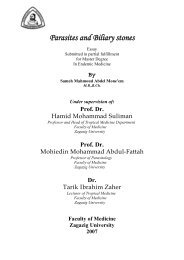E. Coli
E. Coli
E. Coli
Create successful ePaper yourself
Turn your PDF publications into a flip-book with our unique Google optimized e-Paper software.
1. INTRODUCTION<br />
Introduction<br />
Group of Enterobacteriaceae in human includes several that cause<br />
primary infections of the human gastrointestinal tract. Bacteria that<br />
affect the gastrointestinal tract include certain strains of E. coli and<br />
Salmonella, Shigella, and Yersinia entercolitica. Members of this<br />
family are major causes of opportunistic infection (including<br />
septicemia, pneumonia, meningitis and urinary tract infections).<br />
Examples of genera that cause opportunistic infections are:<br />
Citrobacter, Enterobactcr, Escherichia, Hafnia, Morganella,<br />
Providencia and Serratia. Selection of antibiotic therapy is complex<br />
due to the diversity of organisms. The mortality and morbidity are<br />
much higher for the ages less than two years than in older one, fever,<br />
sever loss of electrolyte and dehydration accompanied with watery to<br />
bloody diarrhea (Forfor and Arneil, 1978).<br />
Many species are intestinal pathogens or commensals in the<br />
intestine of man and animal, few are saprophytes in soil and water.<br />
Some species are also transmitted between man and animals (WHO,<br />
2000).<br />
The most common serotypes are E. coli O157:H7 and E. coli<br />
O26:H11. These are unique from the enteropathogenic E. coli (EPEC)<br />
organisms that are the main causes of infantile diarrhea (Shebib et al.,<br />
2003).<br />
Avian pathogenic E.coli (APEC) cause aerosacculitis, poly-<br />
serositis, septicemia in chicken. APEC isolates commonly belong to<br />
1
















